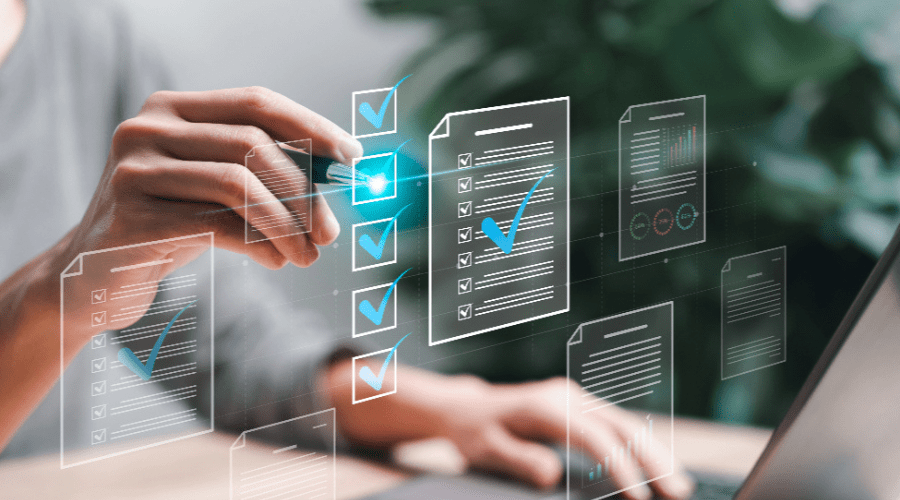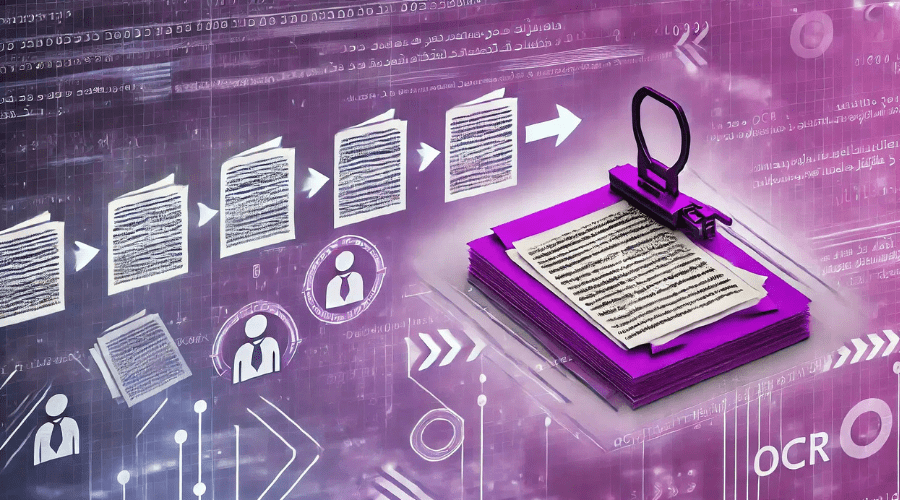Have you ever struggled with manually typing out text from a scanned document or image? OCR technology eliminates this hassle by transforming printed text into editable digital formats. But how optical character recognition works is more than just scanning—it involves advanced algorithms, machine learning, and AI-driven enhancements. In this article, DIGI-TEXX will break down the entire OCR process, helping you understand its functionality and benefits.
What is Optical Character Recognition (OCR)?
Optical Character Recognition (OCR) is an advanced technology that enables the conversion of printed or handwritten text into machine-readable digital formats. This process allows computers to recognize and extract text from scanned documents, images, and even handwritten notes, transforming them into editable and searchable files. OCR technology is widely used in various industries, including finance, healthcare, retail, and government sectors, where document processing and data extraction play a crucial role.
OCR systems leverage artificial intelligence (AI), machine learning, and advanced algorithms to improve text recognition accuracy. Modern OCR solutions not only identify individual characters but also analyze the structure of entire documents, ensuring that formatting, tables, and layouts are preserved. As a result, businesses can automate tedious data entry tasks, enhance accessibility, and manage vast amounts of information more efficiently.
=> Find out more in our detailed article: Understanding Optical Character Recognition and Its Applications
Benefits of OCR Technology
OCR technology offers numerous advantages, making it an essential tool for businesses and individuals dealing with large volumes of text-based information.
Increased Efficiency and Productivity
Traditional data entry methods require significant time and effort, often leading to inefficiencies in workflow management. OCR eliminates the need for manual typing by instantly converting printed or handwritten text into digital data. This allows organizations to speed up document processing, improve turnaround times, and allocate resources to more strategic tasks, ultimately boosting overall productivity.
Reduced Human Errors in Data Entry
Manual data entry is prone to typographical errors, misinterpretations, and inconsistencies. OCR technology reduces these risks by automating text extraction with high accuracy. Advanced OCR solutions incorporate AI-powered corrections and contextual analysis, ensuring that the extracted data closely matches the original content. This leads to more reliable documentation, fewer mistakes, and improved decision-making based on accurate information.

Improved Searchability and Data Organization
One of the major advantages of OCR is its ability to transform physical or image-based documents into fully searchable digital files. When a document is processed using OCR, the extracted text can be indexed and categorized, making it easier to retrieve information using keywords or metadata. This feature is particularly beneficial for industries that manage large document repositories, such as legal firms, libraries, and corporate archives, where quick access to information is crucial.
Cost Savings for Businesses
Implementing OCR technology helps businesses cut down operational costs by reducing the dependency on manual labor for document management. By automating text recognition and data extraction, organizations can save time, reduce administrative expenses, and minimize errors that could lead to costly corrections. Additionally, OCR-powered automation enhances workflow efficiency, allowing companies to handle more tasks with fewer resources, ultimately improving profitability.
How Does OCR Work?

Optical Character Recognition (OCR) is a multi-step process that converts printed or handwritten text into machine-readable digital content. The accuracy of OCR depends on several factors, including image quality, text clarity, and the sophistication of the OCR algorithms. Below, we break down how optical character recognition works step by step.
Image Acquisition and Scanning
The first step in the OCR process is capturing the image of a document using a scanner, digital camera, or mobile device. The document can be a printed page, a handwritten note, a receipt, or any other text-based material. The quality of this initial image is crucial because clear, high-resolution images improve text recognition accuracy, while poor-quality scans may lead to errors in extraction.
OCR software is often integrated with scanning devices to directly process scanned documents. Additionally, mobile OCR applications allow users to capture and convert text from photos taken with smartphones, making OCR accessible and convenient.
Preprocessing: Cleaning and Enhancing the Image
Before the OCR engine can recognize text, it must clean and enhance the image to remove any imperfections that may interfere with character recognition. This step includes:
- Noise Reduction: Eliminating unwanted spots, smudges, or distortions that could affect text clarity.
- Contrast Adjustment: Enhancing contrast between text and background to make characters more distinguishable.
- Binarization: Converting the image into a black-and-white (binary) format, where text is represented in black and the background in white.
- Skew Correction: Adjusting misaligned or tilted text to ensure proper character detection.
These preprocessing steps significantly improve OCR accuracy by ensuring that only clean and well-defined characters proceed to the next stages.
Character Segmentation and Feature Extraction
Once the image is processed, OCR software breaks down the text into smaller components to facilitate recognition. This involves:
- Line Segmentation: Identifying and separating different lines of text.
- Word Segmentation: Recognizing individual words within a line.
- Character Segmentation: Isolating each letter or symbol to analyze its shape and structure.
After segmentation, OCR extracts key features of each character, such as edges, curves, intersections, and stroke patterns. This feature extraction step allows the software to distinguish between similar-looking characters.
Pattern Recognition and Text Conversion
At this stage, OCR software applies two primary methods to recognize and convert characters into digital text:
- Pattern Recognition: The software compares segmented characters with a database of predefined character templates. This approach is effective for recognizing standard fonts and printed text.
- Feature Detection: Instead of matching entire characters, this method analyzes individual features like curves, lines, and stroke angles. It is more adaptable for recognizing various fonts, handwriting, and distorted text.
By applying these recognition techniques, OCR translates visual characters into machine-readable text that can be stored, searched, or edited.
Post-Processing and Text Output
The final step is refining the extracted text to ensure maximum accuracy. OCR software uses:
- Grammar Rules and Contextual Analysis: AI-driven algorithms check for spelling errors, grammatical inconsistencies, and contextual relevance.
- Dictionary Matching: The software cross-references recognized words with a built-in dictionary to correct potential misinterpretations.
- Layout Retention: Advanced OCR solutions preserve formatting elements such as tables, bullet points, and columns to maintain document structure.
Once these refinements are made, the processed text is exported into various formats, such as plain text, searchable PDFs, Word documents, or database entries. This ensures that the extracted information is not only accurate but also usable for further processing, editing, or storage.
Applications of OCR Technology
By converting printed or handwritten content into digital formats, OCR enhances efficiency, accuracy, and accessibility across various industries. Below are some of the key applications of how optical character recognition works in different sectors.
Digitizing Printed Documents
One of the primary uses of OCR is the conversion of physical documents into digital formats. Businesses, educational institutions, and government agencies use OCR to scan and store important records, making them editable, searchable, and easier to retrieve. Instead of manually searching through paper archives, users can quickly find information using keywords or metadata.
Additionally, OCR preserves document structure, ensuring that formatting, tables, and special characters remain intact. This is particularly beneficial for organizations that manage large volumes of paperwork, such as legal firms, historical archives, and research institutions.

Automating Data Entry in Businesses
Manual data entry is time-consuming and prone to errors. OCR eliminates the need for manual input by automating the extraction of information from documents such as:
- Invoices and Receipts: OCR captures key details like invoice numbers, dates, and payment amounts, streamlining accounting processes.
- Customer Forms: Businesses use OCR to extract customer data from application forms, surveys, and contracts, reducing processing time.
- Financial Statements: Banks and financial institutions utilize OCR to digitize reports, tax documents, and transaction records, improving efficiency and accuracy.
By integrating OCR into business workflows, organizations can significantly reduce administrative burdens, minimize human errors, and improve operational efficiency.
=> See more: How Automated Document Processing Software Transforms Workflow Management
AI-Powered OCR in Healthcare and Finance
OCR is particularly valuable in industries where large volumes of critical data need to be processed quickly and accurately.
- Healthcare: Medical institutions use OCR to digitize patient records, prescriptions, and lab reports, allowing healthcare professionals to access and share information seamlessly. OCR-powered systems also enhance medical billing and insurance claim processing by extracting data from documents automatically.
- Finance: Banks and financial services use OCR for check processing, invoice scanning, loan applications, and compliance reporting. AI-driven OCR solutions analyze financial documents in real time, reducing paperwork and improving fraud detection.
As OCR technology evolves, its integration with AI and machine learning continues to enhance recognition accuracy, making it an essential tool for data-driven industries.
=> Check out out article: The Benefits of AI-Powered Document Automation for Efficiency
OCR for Language Translation and Accessibility

OCR has also played a crucial role in language processing and accessibility, breaking down language barriers and aiding individuals with disabilities.
- Real-Time Language Translation: OCR-powered translation tools can recognize and translate printed or handwritten text in multiple languages, making cross-border communication easier. This is especially useful in travel, global business, and education.
- Assistive Technology for the Visually Impaired: OCR helps convert printed text into audio or Braille formats, enabling visually impaired individuals to access books, documents, and digital content more easily. Screen readers and mobile apps powered by OCR make real-world text accessible to everyone.
Challenges and Limitations of OCR
While Optical Character Recognition (OCR) is a powerful tool for automating text extraction and document processing, it is not without challenges. Certain factors can impact OCR accuracy and efficiency, including:
- Handwriting Recognition Difficulties: Unlike printed text, handwritten documents vary in style, size, and slant, making accurate recognition challenging. While AI-powered OCR solutions are improving in this area, handwriting recognition remains less reliable than printed text conversion.
- Low-Quality or Distorted Text: Poorly scanned documents, faded ink, low-resolution images, or distorted text (e.g., crumpled or skewed pages) can lead to errors in recognition. Preprocessing techniques such as noise reduction and contrast enhancement help mitigate these issues but are not always foolproof.
- Complex Formatting and Layout Variations: OCR struggles with multi-column layouts, tables, charts, and mixed fonts within the same document. Inaccuracies often arise when trying to maintain original formatting, requiring manual corrections.
- Language and Character Variations: Some OCR solutions may not support less common languages, special characters, or scripts such as Arabic, Chinese, or handwritten cursive. This can limit usability for international applications.
- Post-Processing Adjustments: Even with advanced AI enhancements, OCR output often requires post-processing corrections to refine text accuracy and maintain consistency.
Despite these challenges, continuous advancements in AI, machine learning, and natural language processing (NLP) are improving OCR’s ability to handle complex text recognition tasks with higher precision.
Why Choose DIGI-TEXX for OCR Solutions?
As businesses increasingly rely on OCR for document automation and data processing, choosing the right solution is essential. DIGI-TEXX offers state-of-the-art OCR technology designed to meet the evolving needs of various industries.
Cutting-Edge AI Technology
DIGI-TEXX integrates advanced AI and machine learning algorithms to enhance OCR accuracy, even for complex layouts, multilingual text, and handwritten documents. Our AI-driven approach continuously learns and adapts, ensuring improved recognition over time.
Customizable OCR for Various Industries
We understand that different industries have unique requirements. DIGI-TEXX provides tailor-made OCR solutions for:
- Finance: Automated processing of checks, invoices, and financial reports.
- Healthcare: Digitization of patient records, prescriptions, and medical forms.
- E-Commerce: Efficient data extraction from product catalogs and invoices.
- Government & Legal Sectors: Secure digital conversion of contracts, legal documents, and archives.
Our flexible OCR solutions enhance operational efficiency while ensuring compliance with industry standards.
Proven Track Record with Global Clients
With years of experience and a global client base, DIGI-TEXX has successfully helped businesses optimize document workflows, reducing manual effort and increasing productivity. Our expertise in handling large-scale document processing projects makes us a trusted partner for businesses worldwide.
Affordable and Scalable Solutions
Whether you’re a small business or a large enterprise, our OCR services are cost-effective and scalable, allowing you to process documents efficiently without exceeding your budget. We provide cloud-based and on-premise OCR solutions, ensuring flexibility and seamless integration with existing workflows.
By understanding how optical character recognition works, businesses can leverage OCR to automate document processing, improve accuracy, and drive data-driven decision-making. With DIGI-TEXX’s AI-powered solutions, you can enhance efficiency, reduce costs, and accelerate digital transformation across industries. Let us help you harness the power of OCR for your business today!


